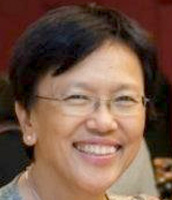SUMMARY
This is AI generated summarization, which may have errors. For context, always refer to the full article.

On June 12, 2013, during the celebration of the 115th anniversary of the country’s proclamation of independence, President Benigno Aquino III said:
“Let us not wait three hundred years, or three decades, or even three years, before we resolve to come together and gain freedom from hunger, poverty, or whatever threatens our sovereignty and security. It is not right for Filipinos to have to stand suffering for even one minute longer.”
Before he became president, and during his campaign for the presidency in 2010, he declared, “The first step has to be freedom from hunger. Once that is settled, the other empowering can take place.”
President Aquino’s dream has yet to be realized. People still go hungry, up to this day. Prices of rice and galunggong, according to the Philippine Statistical Agency (PSA), have gone up. And people could ill afford to buy food.

The PSA estimated that in 2012, the proportion of Filipino families in extreme poverty whose incomes are not sufficient to meet basic food needs stands at 7.5%, or about 10.4 million families. This is almost the same as figures in 2009 – about 7.9%, or roughly 10.9 million families.
Government officials, rice and coconut farmers, fisherfolk, economists, food and health NGOs point to several factors that affect hunger: anything that affects access to food, including graft, corruption, smuggling, and food cartels, and specifically, jobs; assets like land and animals; the production, supply, and prices of food, which are critical.
Nutritionists and medical doctors remind us that consumption of food, particularly the wrong kinds, and the body’s ability to absorb them are likewise crucial. Children with worms, for instance, have difficulty absorbing food nutrients.
Poverty – and how this administration plans to deal with it – is in NEDA’s Philippine Development Plan 2011-2016. But here are some challenges that need to be discussed.
Challenges
Food wastage
Wastage occurs as a result of improper methods of harvesting and post-harvest activities such as storage, drying, transportation, processing, and packaging. According to Agriculture Secretary Processo Alcala, about one million metric tons of rice go to waste due to inefficient post-harvest facilities. This is more than the 860,000 metric tons of rice that the country imported in 2012.
PhilMech data show that post-harvest losses from harvesting to storage average 42% for vegetables; 23% to 32% for fruits; and 12.70% for corn. Reasons behind such losses include the inability of farmers to buy appropriate pos-tharvest facilities; insufficient post-harvest training and extension activities; lack of information on improved technology and prices; and weak linkages between producers and the market.
At the household level, the Philippine Rice Institute reports that every Filipino wastes 3.3 kg of rice a year, which is 308,833 metric tons of national wastage annually. If wastage was totally avoided, the country could have saved P5.3 billion worth of imports.
Roads
In its 2012 yearend report, the Public Works department said that about 80.52% of national roads, 31.3% of provincial roads, and 62.43% of city roads, are paved.
A PIDS case study on Mindanao and the impact of infrastructure and logistics on interregional trade showed that bad roads made markets inaccessible to smallholders and growers, increased their transport costs, as well as the risks of spoilage and the quality of their produce.
The study also pointed out that good road networks are significantly correlated with increased incomes and sustained economic growth, but that this effect is more pronounced for local rather than national roads.
Based on 2002 data, Public Works data showed that only 34.1% of municipal roads and only 6.59% of barangay roads are paved.
Shipping and ports
In his 4th State of the Nation Address on July 22, 2013, President Aquino urged legislators to amend the Cabotage Law to “foster greater competition and to lower the cost of transportation for our agricultural sector and other industries.”
Section 902 of the law explicitly states: “The right to engage in the Philippine coastwise trade is limited to vessels carrying a certificate of Philippine registry.” No foreign-registered vessel, therefore, is allowed to carry any goods or passengers between any two points in the country. If a container cargo enters Philippine territory and docks in the South Harbor Port, the goods in this vessel have to be unloaded and transferred to a local vessel to reach Davao or Iloilo.
The costs then of transporting a container cargo within the country are higher than the cost of bringing it in. According to The Freeman’s Fidel Abalos, a foreign shipping line carrying one 20-foot equivalent unit (TEU) from Hong Kong to Cebu charges about US$100 (P4,400), while a domestic shipping line charges about P15,000 from Cebu to Cagayan de Oro for one TEU.
The lack of facilities in our ports such as warehouses and silos to accelerate the processes of loading and unloading bulk cargo also causes costly delays.
Family size and rice yields
According to a primer prepared by the Philippine Rice Research Institute, the Philippines harvested only 4.53 million hectares, which is 58.7% and 39.1% lower than Thailand and Vietnam, respectively.
Further, it said that given the country’s population growth rate, the country feeds more people per unit area compared to Thailand and Vietnam, which are rice-exporting countries. In 2009, the country fed about 20 persons per hectare of rice area harvested. Thailand and Vietnam fed only 6 and 12 persons, respectively.
The 2010 census reported that the population increased at a rate of 1.9% annually, on the average, during the period 2000-2010. This means that there were two persons added per year for every 100 persons in the population.
Extreme weather conditions
The Climate Change Commission (CCC) observed that for several decades now, category 5 typhoons like Bopha and Haiyan, have been passing through the Philippines.
Such typhoons – and even less severe typhoons – cause deaths, disrupt lives, and destroy livelihoods. According to the CCC, typhoons would cost the country approximately 5% of its GDP. To put this in perspective, when typhoons hit developed countries, these cost them only about 1% of their GDP.
No lead agency on hunger
There is no single lead agency responsible and accountable for alleviating hunger and providing food security in this country. There are about 21 agencies with mandates that directly and indirectly affect the production, provision, storage, transport, processing, marketing, research, and financing of food, as well as the efforts directed at making sure people are able to buy nutritious food.
For instance, the departments of agriculture, agrarian reform, environment and natural resources, and the local government units (LGUs) are responsible for the management, provision of resources, and production of food. The Social Welfare department is responsible for providing social protection to the vulnerable, poor, and disadvantaged. The National Nutrition Council of the health department is tasked to coordinate and integrate policies and programs of all government agencies on nutrition.
There is no single body that is responsible for coordinating and strategically linking the efforts of these and other agencies.
Government officials and academicians, legislators and LGUs, the private sector and NGOs, have proposed a number of solutions to make food accessible to every Filipino. But all these require a whole-of-government approach so that these efforts become coherent, conscious, deliberate, and persistent. And somebody – the President – should take the lead, assume the responsibility, and be accountable for every Filipino who goes hungry. – Rappler.com
Editor’s Note: This was distilled from a paper entitled, “The Food and Nutrition Security Framework” written for DSWD on Nov 3, 2013.
Marilen J Dañguilan, a medical doctor, is an independent consultant who works on food and health.
Add a comment
How does this make you feel?
There are no comments yet. Add your comment to start the conversation.